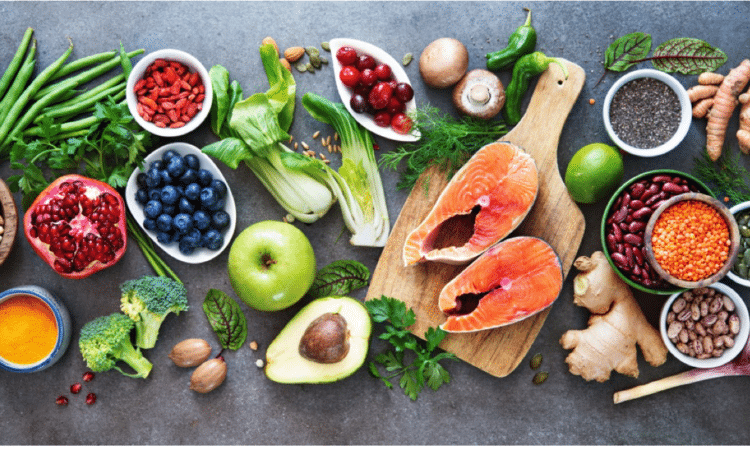POTS Diet: 6 Dietitian-Approved Tips
6 Minute Read
Explore simple, science-based nutrition strategies to support hydration, digestion, and symptom relief in daily life.

What is POTS?
Ever felt lightheaded and dizzy just from standing up? Or like your heart was pounding out of your chest for no reason? Maybe brain fog hits mid-conversation, or a meal leaves you more exhausted than energized. You’re not alone.
Living with Postural Orthostatic Tachycardia Syndrome (POTS) can make even the most basic tasks feel like an uphill battle. POTS is a condition where simply standing up can cause your heart to race.
It’s an issue stemming from the autonomic nervous system. This system manages functions like heart rate and digestion without our conscious control.
According to Dysautonomia International, POTS affects an estimated 6 million people in the United States alone.
How POTS Affects Daily Life
For those of us with POTS, everyday experiences can bring a whirlwind of symptoms. These can range from brain fog and lightheadedness to nausea and digestive troubles. And many more.
Simple things like eating or showering might worsen these symptoms. Daily life then becomes challenging (including preparing food).
Despite these difficulties, managing POTS is more than just taking medication. Diet plays an essential role too.
It is also important to remember that small changes can make a big difference. You don’t need to make all of these changes at once. Start with one or two strategies and build from there.
And please know that you don’t need to be perfect to feel better.
The following nutrition tips can improve symptoms and enhance your quality of life.
Understanding POTS and Diet
There is no one-size-fits-all diet for POTS.
No matter where you are on your health journey, nutrition gives you another tool in your toolbox. The changes you can see with adjusting your nutrition can be small or life changing.
Many people with POTS are first told by their doctor to increase salt and fluid intake. Other recommendations may include supporting digestion and ensuring proper vitamin and mineral levels.
These recommendations aim to help you reduce symptoms from POTS.
Keep in mind that these are general tips. We will dive into more specifics for those experiencing gut issues and more in other posts.
Please adapt these tips according to your particular circumstances. And use them in conjunction with your provider’s recommendations for you.
My Two Cents
As a registered dietitian who also lives with POTS, I’ve spent years experimenting. I tested many different strategies and learned from research to figure out what actually makes a difference.
And I’ve learned managing POTS isn’t about restriction. It’s about adding the right things in. More hydration, more balance, more foods that work with your body instead of against it.
These small shifts add up, and even a 10-20% improvement can make life feel more manageable.
I’m sharing the best tips from both the current research. And I’ll inject some of my personal experience along the way.
These strategies are not only effective but also simple to put in place. It doesn’t matter if you’re a newbie or a veteran looking for ways to better manage your symptoms.
These tips can help improve symptoms and boost your overall health. Read on to discover practical, diet-based changes you can start today to live better with POTS.
Diving Into the Diet For POTS
1. Savor the Salt
The most common diet strategy is taking in more fluids and salt. This powerful combo increases blood volume and its circulation in the body.
Salt and fluids can be helpful for people with blood pooling, low blood volume, and low blood pressure.
Salt recommendations vary from at least 3 grams a day. And some patients may need to increase their salt intake to up to 10 grams per day (4000 milligrams of sodium).
For some perspective, 1 teaspoon of table salt is about 2300 milligrams of sodium.
Some POTS patients may need to take buffered salt tablets, as tolerated, to help reach this amount. For other people, increasing the amount of salt you take in through salty foods may help.
Tips to Incorporate More Salt into Your Diet
While taking in more salt, it’s also important to make nutrient dense choices whenever possible. The closer a food is to nature, it’s often packed with more nutrients like vitamins, minerals and fiber.
Right now, the thought of potato chips has crossed many of our minds. A POTsie go-to for salt!
Chips are fine from time to time for a nice salt boost. But it’s even better to pair them with some protein. Some of my go-to’s are cheese, nuts, pumpkin seeds, dried chickpeas or a hard-boiled egg.
Some simple ways to boost your salt in your diet include:
- salted snacks, like nuts or popcorn
- soups and broths higher in sodium
- pickles and olives (my two faves)
- electrolyte powders
- buffered salt tablets
Of course, there’s always the option to add salt to foods. And don’t be afraid to be creative and use flavored salts for variety.
You can also portion out your added salt for the day in the morning. Then you can add it to foods throughout the day to keep track.
2. Hydration is Key
Drinking plenty of fluids goes hand in hand with salt intake. This ensures that the sodium helps keep the right amount of fluids in your body.
Fluids help increase blood volume and prevent dehydration. Both of which are important in managing POTS symptoms.
Tips for Increasing Fluids
Aim for about 2-3 liters of fluids per day, unless otherwise recommended by your provider.
I know drinking this much can feel impossible, especially if nausea or fatigue makes it hard.
What helped me? Keeping a pre-filled bottle by my bed so I could sip before even standing up.
I also keep a 1 liter refillable bottle with me at all times and it helps me know exactly how much I drink in a day. Tracking “glass by glass” with brain fog is way too tough.
You can always flavor water with lemon, lime, herbs like mint or basil. And of course, flavored electrolyte packets can help change it up.
3. Opt for Small, Frequent Meals
Have you ever felt like you need a nap after eating a big bowl of pasta? That’s your body struggling with blood flow redistribution.
Up to 35% percent of your blood volume is in your gut after eating. A little tweak in timing and amount of food can make a world of difference.
This increased blood flow to the digestive system can lead to a decrease in blood flow to other parts of the body. This includes less blood to the brain and heart. If you’ve ever gotten an increase in symptoms after a big carby meal, this is why!
In POTS, the autonomic nervous system may not compensate well with big meals. This is because digestion needs more blood. This leads to – you guessed it – more symptoms. They include dizziness, fatigue, a faster heart rate, and for some it’s fainting.
Eating smaller, more frequent meals can help avoid large shifts in blood volume. These large shifts often occur after a large meal.
This timing can also help keep blood sugar levels stable. This can help if you get brain fog, shakiness, dizzy, or lightheaded when going too long between eating.
Tips for Small, Frequent Meals and Snacks
Focus on balanced meals and snacks. They should combine carbohydrates, proteins, and fats. This balance maintains energy levels and helps reduce gastrointestinal discomfort.
Keep easy snacks on hand. These include: cheese, crackers, salted nuts, and fresh fruit. Also, hummus, pre-cut veggies, yogurt, pumpkin seeds, and trail mix. These are helpful in case you don’t have the energy to make something.
4. Aim for Variety
Many with POTS have digestive concerns and food sensitivities. This can become challenging when trying to eat a wider variety of foods. Some days may be better than others, however it is important to eat as wide a range of foods as you can tolerate.
If you’re having continued issues that limit what you eat, it can be helpful to talk to your doctor or a dietitian. A dietitian can help come up with nutrition strategies that are specific to you. You can also collaborate to decide if you need to check certain vitamin and mineral levels.
Low vitamin or mineral levels can lead to symptoms, including fatigue and brain fog. If you cannot tolerate some food groups, you might need supplements to fill gaps. Before taking anything new, even supplements, talk to your medical team.
5. Dig Into Food Sensitivities
Some food sensitivities can take two to three days to show symptoms in your body. Keeping track of your symptoms using a food diary or app can pinpoint if there are specific patterns.
This will give you a better idea as to what foods or beverages are bothering you. Then you won’t remove other foods without needing to.
Some research suggests POTSies are more likely to be gluten sensitive or have celiac disease. Also, other research notes that a gluten-free diet can reduce gut symptoms in POTS patients. Even if they don’t have celiac disease.
If you’re experiencing digestive issues, you might consider reducing or cutting out gluten to see if it helps. Some people find this relieves their symptoms.
Talk to your doctor before removing gluten since they may want to rule out celiac disease first.
Celiac disease is an autoimmune condition that requires lifelong, strict gluten avoidance. While gluten sensitivity does not cause the same long-term damage.
6. Keep an Eye on Caffeine and Alcohol
Caffeine can constrict blood vessels and raise heart rate. This might help some POTS patients by increasing blood pressure. But, it can also cause palpitations. Be mindful when consuming caffeine and pay attention to how your body responds.
Alcohol is a diuretic (making you pee more often) and can lead to dehydration. It can also block the body’s ability to regulate blood volume and can increase heart rate.
Alcohol provides short-term sleep aid, but it undermines sleep quality. Poor sleep can aggravate fatigue, another common symptom in POTS.
People with POTS should pay close attention to their alcohol intake. Some may feel better by drinking much less. While others need to steer clear from alcohol altogether. This will depend on how it affects your symptoms.
Putting It All Together
Making small changes to your diet doesn’t mean overhauling everything at once. Simple, realistic shifts—like adding extra salt, spacing out meals, or drinking more fluids—can make a real difference in how you feel.
Start with one or two changes, track how your body responds, and adjust as needed. A simple food and symptom journal can help you spot patterns along the way.
Working with a healthcare provider who understands POTS can help tailor these strategies to your needs, ensuring you’re making the best choices for your body.
You don’t have to figure this out alone.
Want to take the next step?
My blog breaks down the basics, but my 5 Easy Steps to Increase Energy & Manage POTS Symptoms Guide goes even deeper. It’s packed with specific, practical strategies for hydration, digestion, and blood sugar balance—so you can start making real, manageable changes today. Grab your free copy!

PS If you’re new around here, Hey! My name is Louisa and I’ve been a Registered Dietitian helping people with chronic conditions for over 16 years. I help people with POTS find simple, realistic nutrition strategies that actually fit their energy levels and daily life.
